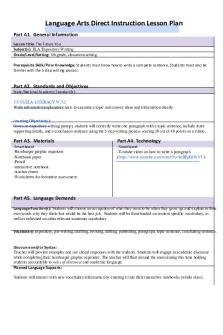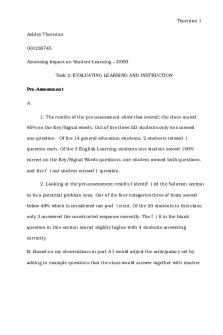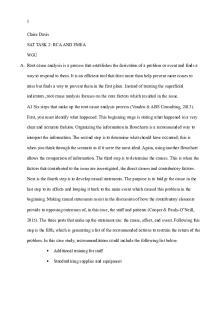C365 Task 2 PDF

| Title | C365 Task 2 |
|---|---|
| Author | Michael McDowell |
| Course | Language Arts Instruction and Intervention |
| Institution | Western Governors University |
| Pages | 5 |
| File Size | 189.1 KB |
| File Type | |
| Total Downloads | 112 |
| Total Views | 165 |
Summary
Passed first time go....
Description
LESSON PLAN TEMPLATE – 2015 GENERAL INFORMATION Lesson Title & Subject(s): Writing an Expository Paragraph Topic or Unit of Study: Writing for a Variety of Purposes Grade/Level: 3rd Grade Instructional Setting: This lesson will take place in a 3rd grade classroom that consists of 23 students, two of which are English Language Learners. These students will be working in groups of 2-3 students. A word wall will be on display for the students to use.. STANDARDS AND OBJECTIVES Your State Core Curriculum/Student Achievement Standard(s): 3.9 The student will write for a variety of purposes. a) Identify the intended audience. b) Use a variety of prewriting strategies. c) Write a clear topic sentence focusing on the main idea. d) Write a paragraph on the same topic. e) Use strategies for organization of information and elaboration according to the type of writing. f) Include details that elaborate the main idea. g) Revise writing for clarity of content using specific vocabulary and information. Lesson Objective(s): The student will write an expository paragraph, including a topic sentence, three supporting sentences, and a concluding sentence, and score a 3 out of 3 on each section of a rubric. MATERIALS AND RESOURCES Instructional Materials:
Writing Guide (Reading Rockets, n.d.) 25 Copies Writing Instructions 25 Copies Pencil and Paper Word Wall or Word Chart Electronic Smartboard and Projector Spanish/English dictionary for ELL Students and regular dictionaries of other students. 25 copies of the Steps of the Writing Process.
Resources: Reading Rockets. (n.d.). Paragraph Hamburger. Retrieved July 27, 2017, from http://www.readingrockets.org/strategies/paragraph_hamburger.
INSTRUCTIONAL PLAN Sequence of Instructional Procedures/Activities/Events (provide description and indicate approximate time for each): 1. Student Prerequisite Skills/Connections to Previous Learning:
The students will need to be able to work with their partners and in their small groups. They will need to know what syntax and grammar are. Moreover, the students will need to know what a topic sentence is, as well as supporting details and conclusion sentence. 2. Presentation Procedures for New Information and/or Modeling: Presentation Procedures for New Information:
The purpose of the lesson is to teach students how to write an expository paragraph. I will ask the students if they had ever explained how to do something or told someone about their favorite toy or book. Once the students answer, I will request that they join up with their assigned partners and give a brief explanation of how to perform a simple task such as, making a peanut butter and jelly sandwich. After all the students have had a opportunity to complete this task, I will inform them that they will be writing as expository paragraph, which is defined as a paragraph that gives information or explains something. Afterwards, we will discuss and review the steps of the process approach to writing which consists of prewriting, composing, revising, editing, and publishing. Prewriting is brainstorming ideas regarding what they will be writing about. Composing is writing a first draft of the paper while ignoring mistakes. Revising is when information is added or deleted if necessary, rearranging sentences if needed, and replacing any words with more interesting words. The editing portion is when spelling, grammar, punctuation is checked and corrected. Publishing is when the final product is turned in. Modeling:
For modeling, I will use think aloud to demonstrate how to write an expository paragraph. I will explain the prewriting process and brainstorm what it is I want to say about my topic. For a visual presentation, I will have the topic of my paper projected onto the Smartboard so the students can see and follow along. Afterwards, I will model the drafting steps, where I will introduce the writing guide. I will explain to the students that the writing will assist them by ensuring that they have included all the parts of their expository paragraph. After we finish the discussion on the writing guide, I will create a rough draft of my paragraph, which will consist of the topic sentence, three sentences containing facts and information about my topic, and finally my conclusion sentence. I will tell them that at this point of the paper that I’m not concerned about making mistakes because I will fix them in later steps. I will move into the revision portion, where I take away any information that isn’t needed, add information that I left out, and/or rearrange information that makes the flow of the paragraph sound better. Once I have finished the revision, I will move onto model editing, where I will check for spelling, punctuation and grammar errors which will take us to the final step, publishing which I will present to the class. 3. Guided Practice: For the guided practice, I will be working with the students in mini group lessons. Each group will have a practice topic that each student will know something about such as school food. Each student will be given a writing guide that will outline what they
should have in their paragraphs. The ELL students will be given the writing guide in their native language as well as English. I will explain the writing steps to the ELL students in simpler English or use Google Translate so they are able to follow along. The instructions will include the five steps of the writing process: prewriting, composing, revision, editing, and publishing. Step One: Prewriting The students will practice prewriting by brainstorming at a minimum, three facts about the topic that they were assigned. Once they have brainstormed their ideas and written them down, they will be instructed to continue to the next step which is composing. Step Two: Composing The students will follow the writing guide and put together all the information that they have collected, included extra information that they had gathered. They will put all their information into complete sentences and after they have completed this task, we will move onto revision. Step Three: Revision Following the writing guide, we will review the information and determine if we need to add or delete any information if they have too much or not enough. We will also be checking the word wall to see if it has any words that can be used instead to make their paragraphs sound more appearing and interesting. They can also use their tablets to search for more words as well. Once we are finished with revising, we will move onto editing. Step Four: Editing In the editing process, we will check for spelling, grammar, and syntax errors. If students are having trouble with words, they will be able to search for correct spelling in their dictionaries, tablets, or ask for help. Once they have completed editing, we will move onto publishing. Step Five: Publishing In this step, students will trade their paragraphs with other students. I will make it clear that publishing the paragraph to be assessed means that they will be turning it in to me rather than reading it to their peers. 4. Independent Student Practice: Once every student has had an opportunity to see me in their mini group lesson, each student will write another paragraph on a different topic. Each student will choose a person they may know then write three facts about that person. The facts may include physical features, favorite food, etc. or can be a combination of the students choosing. Afterwards, the students will write their five-sentence paragraph following their step-bystep instruction and the writing guide. All students will be given a copy of the rubric since the paragraph will be turned in for grading. 5. Culminating or Closing Procedure/Activity/Event:
At the conclusion of the lesson, we will review what expository writing us. Every student will write on an exit ticket their own definition of what expository writing is. They will also answer questions to review the steps of the process approach to writing. On a sheet of paper, each student will arrange the step of the process approach to writing in order, I will roam around the classroom to verify that students are arranging the steps in the correct order. Instructional Strategy (or Strategies): Direct instruction was used in modeling. Small groups were used in guided practice. Differentiated Instruction Accommodations: For the ELL students, they will be given the writing guide and instructions in the native language. Simpler English will also be used to explain the writing steps. For students who have issues with fine motor skills, they will be able to use, laptops, or iPads instead of using pencil and paper to write the paragraphs. Use of Technology: For this lesson, we used a smartboard for modeling and each student was allowed to use their tablets during the guided practice. Student Assessment/Rubrics:
Student Rubric-Expository Writing
Topic Sentence
Supporting Sentences
1: Doesn’t Meet Expectations The student does not provide a topic sentence
The student does not provide any supporting details.
2: Approaching Expectations The student provides an incomplete topic sentence (only gives a fragment or does not explain what the paragraph will be about. The student provides an incomplete topic sentence (only gives a fragment or does not explain what the paragraph will be about.) The student only provides 1-2 supporting details, or details are not
3: Meets Expectations The student provides a clear, complete topic sentence that explains what the student will be talking about in the paragraph.
The student provides three clear, relevant supporting details.
Conclusion sentence
The student does not provide conclusion sentence.
relevant to topic. The student provides 3 details, but do not support topic The student provides an incomplete sentence (a phrase) or does not summarize the information in the paragraph.
The student’s conclusion sentence is complete and summarizes the information present in the paragraph....
Similar Free PDFs

C365 Task 2
- 5 Pages

C365 - Task 1 - Task 1
- 4 Pages

C365 Lesson Plan Task 1.docx
- 8 Pages

Task 2 - Task 2
- 5 Pages

QHT1 Task 2 - Task 2
- 1 Pages

Task 2 - C226 Task 2
- 7 Pages

D082 Task 2 - Task 2
- 3 Pages

TDT1 Task 2 - Task 2
- 4 Pages

TET1 Task 2 - Task 2
- 4 Pages

DO81 - Task 2 - Task 2
- 5 Pages

C228 Task 2 - Task 2
- 6 Pages

D081 - Task 2 - Task 2
- 2 Pages

D093 Task 2 - task
- 6 Pages

Final CPC TASK 2 - task 2
- 44 Pages

Task 2
- 8 Pages

Task 2
- 10 Pages
Popular Institutions
- Tinajero National High School - Annex
- Politeknik Caltex Riau
- Yokohama City University
- SGT University
- University of Al-Qadisiyah
- Divine Word College of Vigan
- Techniek College Rotterdam
- Universidade de Santiago
- Universiti Teknologi MARA Cawangan Johor Kampus Pasir Gudang
- Poltekkes Kemenkes Yogyakarta
- Baguio City National High School
- Colegio san marcos
- preparatoria uno
- Centro de Bachillerato Tecnológico Industrial y de Servicios No. 107
- Dalian Maritime University
- Quang Trung Secondary School
- Colegio Tecnológico en Informática
- Corporación Regional de Educación Superior
- Grupo CEDVA
- Dar Al Uloom University
- Centro de Estudios Preuniversitarios de la Universidad Nacional de Ingeniería
- 上智大学
- Aakash International School, Nuna Majara
- San Felipe Neri Catholic School
- Kang Chiao International School - New Taipei City
- Misamis Occidental National High School
- Institución Educativa Escuela Normal Juan Ladrilleros
- Kolehiyo ng Pantukan
- Batanes State College
- Instituto Continental
- Sekolah Menengah Kejuruan Kesehatan Kaltara (Tarakan)
- Colegio de La Inmaculada Concepcion - Cebu